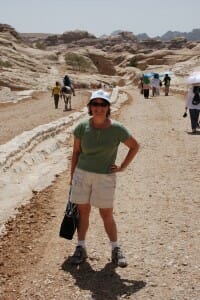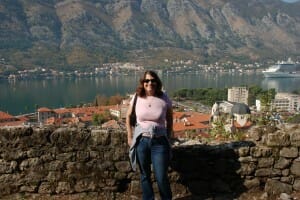
In the fall of 2004, I was driving on the Boulder-Denver Turnpike heading to Westminster Elementary. Without any warning, the car in front of me came to an abrupt stop. I slammed on my breaks. I breathed a sigh of relief. I had avoided a catastrophic collision.
Within milliseconds, I heard the unmistakable sound of metal crashing against metal. “Oh my God,” I screeched as I glanced at my rearview mirror. Another car had nailed the back of my car.
As I drove my car off the highway and onto the center median, my body began to shake uncontrollably. I felt nauseas. I sat motionless. One minute, two minutes and possibly more time passed by. I was thankful. I had not been smashed between two or more cars.
The driver of the car remained in her vehicle. With wobbly legs, I made my way to her car as vehicles whizzed by. The back end of my brand new car was dangling on the ground. The engine of her car was leaking vital fluids. I asked her if she was okay. She muttered a few indistinguishable words and mentioned something about needing to leave. I couldn’t understand how she could consider driving away from the scene of an accident, especially when her engine was partially destroyed. I went back into my car. The minutes passed by slowly until the police arrived.
For the remainder of the day, I replayed the accident over and over. I kept reminding myself how lucky I was.
I anticipated waking the next morning with back or neck pain. Neither orthopedic problem happened. At school, I tried to kneel. I flinched when a sharp pain shot through my leg. I could not bend my knee without pain.
During winter break, I had arthroscopic knee surgery to repair the damage. For the first few weeks of my last semester of graduate school (2005), I hobbled from class to class and to physical therapy. I still considered myself lucky.
Months later, my hip started to throb. Physical therapy and exercises brought no relief and in fact only made the situation worse. I procrastinated. I limited my activity. The discomfort became more and more prominent. I hoped that foregoing exercise would eliminate the problem.
A visit to a world-renowned hip specialist brought a diagnosis that I did not want to hear. The MRI showed that I had a congenital defect. An operation would purportedly correct the problem.
After waking up from the lengthy procedure, the surgeon asked if I ever suffered a traumatic event. Huh, had I fallen off of a horse? In my foggy state, I emphatically replied, “no way.” Later, I remembered the accident. The doctor concurred that the damage was most likely related to my car accident. Instead of being on crutches for 2 weeks, the microfracture repair mandated 2 months and daily abdominal injections of a blood thinner.
Like a world class athlete, I diligently followed a regiment that included twice a day physical therapy. My husband provided daily care at home in addition to my frequent visits to a physical therapist.
Both shoulders were heavily taxed by the crutches. Cortisone shots were ordered to relieve the painful inflammation. I poured my heart and soul into the recovery process. I was overcome with joy when I skied on New Year’s Day 2008. It less than 3 months after the operation.
Within months, I could see that my recovery was falling short of the doctor’s expectations. As the pain escalated, I made repeated trips to the doctor. Several rounds of platelet injections were given. None netted the results promised. I limped around and became more and more conscious of my growing limitations. I struggled when I walked on the uneven surfaces in Israel and Petra, Jordan.
Soon, I could barely walk more than a block. I couldn’t stand or sit for extended periods of time. Due to my change in gait, my toes became inflamed and injections were prescribed for my feet. Narcotics gave me a few hours of respite at night. I was miserable.
The orthopedic surgeon refused to return my calls. I felt abandoned. Negativity clouded my judgment. Would I ever be active again? How was I going to tolerate the daily pain?
I visited several Boulder and Denver orthopedic surgeons. Each said the same thing. My 1st hip surgery was a failure. Microfracture repairs of the hip joint are rarely successful. It was unanimous. I needed a total hip replacement.
“Hip replacement. You’ve got to be kidding. Isn’t that something that old people need?”
Bone on bone can happen at any age. If I wanted to be active, I had no choice but to undergo the operation. My fears needed to be put in check. I could not procrastinate. I scheduled the operation. I put the rest of my life on hold as I once again focused on rehabbing my hip.
Three years ago this month, I had a total hip replacement. Without this incredible procedure, I would have been destined to a sedentary life filled with unrelenting surges of pain. I would never have been able to explore and teach in India, climb the wall in Dubrovnik, hike to the St. John’s fortress above Kotor, walk on the cobble at Pompeii, spend an entire day exploring Barcelona, hike in the Colorado Rockies, and ski numerous times each winter season.
I am immensely grateful to the people who did the pioneering hip replacement research, all the medical personnel who continued to perfect the procedure, my surgeon, Dr. Brian Haas, his physician’s assistant, Will Petitt, the office staff at Colorado Joint Replacement Center, and the staff at Porter Adventist Hospital in Denver. Each May, I celebrate this meaningful anniversary. I remember how lucky I am.
Does anyone have a memorable anniversary they’d like to share?
Related Posts
Overcoming a Physical Therapy Setback
10 Tips for Subacromial Decompression Post-Op Recovery
Meaningful Anniversary (hip replacement)
5 Ways to Improve Exercise Motivation
Confronting an Irrational Fear
Precarious Moment- Ski Accident at Keystone Mountain
Coping with the Uncertainties of Life
Bio
Sandra Bornstein is a freelance travel and lifestyle writer. She shares her experiences and recommendations on this blog and on other websites. Sandra contributes a monthly travel tip column for Golden Living, a Best Version Media magazine.
Sandra is the author of MAY THIS BE THE BEST YEAR OF YOUR LIFE. This memoir highlights Sandra’s living and teaching adventure in Bangalore, India. As a licensed Colorado teacher, Sandra has taught K-12 students in the United States and abroad. She also taught college level courses.
Sandra’s memoir was a finalist in the Travel category for the 2013 Next Generation Indie Book Awards, the 2013 International Book Awards, the 2013 National Indie Book Excellence Awards, 2013 USA Best Book Awards, and a Honorable Mention award in the Multicultural Non-Fiction category for the 2013 Global ebook Awards.


Hi – I am a survivor of nearly 20 surgeries and would love to tell my tale as an encouragement to others. I’m 63 and recently retired as a fitness instructor. I’m very active and have two young horses that I train and ride. I’m also a writer (previously free-lance and Canadian Press journalist) and love my relationship with words :). Of course I have several surgical anniversaries but they’re all meaningful to me!
Patrice,
Wow. Thanks for sharing. You have endured a tremendous number of surgeries.
While anniversaries are meaningful, I am grateful every time I participate in a challenging excursion. I just returned from Asia and was thrilled that I could do everything that I set out to do each day. Fortunately, I have had wonderful surgeons and physical therapists who have made it possible. I sincerely hope that you continue to be able to enjoy each day with minimal limitations. Sandy